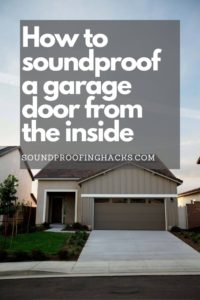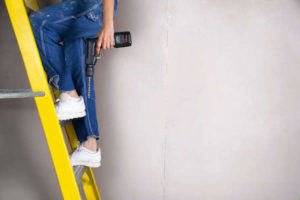How to soundproof a garage door from the inside? 3 easy ways to get started
Sounds get into the house a number of ways: whistling through the chimney, sneaking through exterior-facing walls, and vibrating-muffled through windows.

There is another location that sounds get in, which you may not think of at first until you realize how much of it is getting in your house.
That location is the garage door.
You may enjoy using your garage for hobbies and crafts and are frustrated by the neighbor’s music.
Or your bedroom or office may share a wall with the garage and the garbage truck wakes you up each week.
You might be thinking of remodeling your garage so that it feels more like an additional room in your house. Regardless of which of these instances apply to you, this article will help.
So, if you’re looking to soundproof a garage door from the inside, you will find materials and strategies below. Keep reading!
I am an Amazon Affiliate, which means I may make a commission if you purchase something through the links here. There is NO extra cost to you at all, and THANK YOU so much for the support.
Related: How to soundproof a door with household items
Contents: Skip to section
Why you should soundproof your garage door?
The garage door is probably the least insulated door in your house.
Chances are all four sides of the door are currently letting sound in and the door itself is not much of a sound block.

This all makes it challenging to do projects with wind and debris and potentially weather seeping into your garage through the door.
The strategies in this article will help make your garage door quieter, and cut down on temperature changes and weather and debris getting through.
You do not need to be a specialist of any kind, you simply need a few tools.
In fact, many of the materials discussed below come with their own installation materials: weather-stripping often has adhesive on its back; the door wrap may come with its own screws and nails.
You will need some tough gloves, a razor or sharp working knife, and a measuring tape.
With a few materials and a little work, you will be able to cut back on sound.
Related: How to stop wind from blowing down chimney: 3 simple steps you can follow right now
Strategies you can use to soundproof your garage door
There are several things you can do to do to help soundproof and seal a garage door. It probably does not need pointing out, but there are four sides to your garage door, each of which are potentially leaking air and noise into the house.
You’ll need to seal the bottom, sides, and top, and you will want to insulate the door itself if you can.
While any one of these strategies would help, to get the full effect you will truly need to do each of them.
Related: How to quiet a pool pump: 3 easy steps to start today!
Step 1: Seal Your Garage Floor
Is there a gap between your garage door and floor? If you have leaves blowing in when it is closed, or if you can see sunlight at the bottom of the door, you have a gap. Sound, rain, leaves, and dirt are all getting in through your door there.
Below this section on strategies and steps, in the materials you will see several options for sealing the bottom of your door. These will not only dampen sound, but cut back on mice, rain, leaves, and other debris in your garage.
The steps themselves are pretty succinct:
- Clean your garage; sweep it perfectly clean. Since you’re sealing the number one source of dirt and debris, now is the time to clean the garage. Also, because you are going to be gluing this first strip down to the door threshold, you will want to ensure that part is especially clean.
- Measure your garage door threshold and carefully cut the seal to match.
- Close your garage door and mark the borders on the inside and outside of the door so that you know exactly where to place the strip.
- Open the door, apply Green glue to the flooring between the boundaries you marked.
- Lay down the stripping carefully.
- Let the compound dry for at least 2 days.
Step 2: Sealing the Sides of Your Door
The next major sound gap in your door is along the sides of your door. The best strategy for sealing these sides more tightly is to use weather stripping. Below I will cover the steps to apply weather stripping the sides of your door.
- Most of these products are fast and easy to install.
- Clean the sides of your door thoroughly with hot soapy water. Let it dry.
- Measure the two sides and of your door and cut the stripping to match.
- Many of these strips come with a self-adhesive, which means you can easily attach them without more gluing. If you live in an area with heavy weather patterns or extreme temperature variations, you may wish to add green glue as well. You may need to use a hair dryer to soften the self-adhesive.
- Attach and allow time to try.
Step 3: Sealing the Top of Your Door
One more side of the door to go to having a much quieter garage. There are even garage-door-specific strips for the top of your door.
- This will attach to the top door jamb.
- Measure out the space along the top of your door and clean it.
- Attach this top door sealing using the nails and screws that come with the kit.
Related: How to soundproof a room for drums: Turn it into a reality now!
Soundproofing the Actual Garage Door
Most of this article is about the perimeter of your garage door.
However, there are several items you can use to help prevent sound from traveling through the door itself.
If your door is aluminium, then it barely blocks out any sound.
If it is wood, it probably does a better job of blocking sound transmittal, however you can still add to it.
If your wooden door is hollow, then it is still letting in sound almost as much as the aluminium door.
You have two primary options: acoustic panels and sound insulation wrap. They can work for soundproofing a metal garage door or to soundproof a garage roller door too.
- In either case, measure the spaces on your door between any bracing and the hinges where the door bends to open and slide up along its tracks.
- Cut either the panels or insulation to fit along these gaps.
- You may wish to use Green Glue or heavy industrial tape to hold them on, depending on how permanent you want them to be.
Related: Soundskins vs Dynamat: Battle of the sound deadeners
Recommended Gear
Now that I have discussed the strategies, here are the materials you will need. I have listed out a few options that differs slightly in usage and prices, so do check them out to find one that suits your needs.
Garage Door Bottom Seal
This seal is 20 feet long and can be cut to meet your garage door size. You can glue it to the bottom of the door using the Green Glue recommended below.
Universal Weather-Stripping Seal for Garage Door Threshold
This stripping is twenty feet long. The rubber is designed to withstand heavy weather and temperature variations. Unlike some of the others listed here, this comes with a lifetime warranty.
Green Glue Soundproofing Compound
Green Glue is often recommended for these types of projects. It is a very powerful adhesive and also has the benefits of adding an extra layer of soundproofing.
Weather Stripping for Door
This weather stripping can be attached to the sides of the door, making it weatherproof and much more soundproof. The rubber comes with self-adhesive in a two-pack totaling 33 Ft long.
Silicone Seal Stripping for Door
This silicone weather stripping is over 30 feet long and will cut down of wind, rain and sound coming through the garage door and is designed to withstand heavy weather patterns.
Garage Door Top and Side Seal
All of the seals listed here will work for the garage door, but some are designed specifically for the top of it and are a little more weather-resilient, or sized for garage doors.
This is designed to handle weather fluctuations, cut back on sound, and prevent rain and debris. Rather than being self-adhesive, this requires nails or screws to mount to the doorjamb. Comes with a three-year warranty.
Reach Barrier Polyethylene Insulation
This will help reduce heat and sound passing through your garage door. This comes in a roll, 2-Feet by 25-Feet.
Soundproof Panels
There are many types of sound-proof panels available. These are Amazon’s choice for the category. They absorb and block sound. They come in multiple panels and sizes. This comes in a pack of 50 with size of 1-inch thick X 12 X 12 width and length.
Frequently Asked Questions (FAQ)
Is it expensive to soundproof your garage door?
Relatively speaking none of these materials are very expensive. You have several options of materials and price. The most expensive thing, not listed, would be to replace your door with something specifically designed to be soundproof. However, that is not necessary. Some stripping and other materials are all you truly need.
Why is my garage door loud when I open it?
Warn rollers or hardware that needs tightened or lubricated are the primary culprit for door opening noise. Check each of these and replace, fix, or lubricate as needed.
Will these strategies make much of a difference to soundproof the door?
Yes. Each of these will cut back on the noise level little by little. Once sound drops below a certain threshold, it is much less likely to be heard. These strategies will make a difference.
Related: Best Quiet Vacuum Cleaners 2020: 18 Different Ones Reviewed!
How to seal a garage door from the inside: Conclusion
Your garage is probably letting in more sound than you think.
However, with some stripping, pads, and panels, you will notice a considerable drop in the sound.
Be sure to check out the recommended materials and take this weekend to soundproof your garage door!
Additional Resources:
- How to soundproof a garage? 6 easy steps to get started
- How to make a soundproof box? 10 Simple steps that work
- How to soundproof your bathroom: A private place
- Cheapest way to soundproof a basement ceiling
- How to soundproof an apartment door: Painless DIY Solutions
- 4 Best Quiet Drum Set: Practice Silently At Home!
- Complete Buying Guides
- Latest articles on Soundproofing Hacks








